All amounts are in United States dollars, unless otherwise stated.
TORONTO, Oct. 26, 2022 (GLOBE NEWSWIRE) — Alamos Gold Inc. (TSX:AGI; NYSE:AGI) (“Alamos” or the “Company”) today reported its financial results for the quarter ended September 30, 2022.
“We had a solid third quarter overall, including our highest production in nearly two years. Our operations performed well with production near the top end of quarterly guidance and representing a 19% increase from the second quarter. Our costs were also down significantly from the first half of the year, coming in below full year guidance. With the strong year-to-date performance and even stronger results expected in the fourth quarter, we remain on track to achieve full year production and cost guidance,” said John A. McCluskey, President and Chief Executive Officer.
“La Yaqui Grande was the key driver of our operational and financial performance with an excellent first full quarter of operations. Its low-cost production growth more than offset the lower gold price to drive stronger cash flow from operations. This is a trend we expect to continue with La Yaqui Grande contributing higher production and lower costs over the next few years and Island Gold continuing that trend over the longer term through the Phase 3+ Expansion. Given our growing cash flow from operations, we can fund this growth internally while generating strong free cash flow and supporting solid ongoing returns to shareholders,” Mr. McCluskey added.
Third Quarter 2022
- Produced 123,400 ounces of gold, a 19% increase from the second quarter and near the top end of the range for quarterly guidance. This represented the highest quarterly production in nearly two years driven by a solid first full quarter of production from La Yaqui Grande in Mexico
- With year-to-date production of 326,200 ounces of gold and a further increase in production expected in the fourth quarter, the Company remains on track to achieve full year guidance of 440,000 to 480,000 ounces
- Mulatos District production totaled 42,700 ounces, more than double the second quarter at substantially lower costs driven by low-cost production growth from La Yaqui Grande
- Young-Davidson continued its strong operational performance, producing 49,300 ounces and generating mine-site free cash flow1 of $23.3 million. Year-to-date, Young-Davidson generated $77.3 million of mine-site free cash flow and is on track to generate $100 million for the second consecutive year
- Construction activities on the Phase 3+ Expansion ramped up at Island Gold, including the start of the pre-sink of the shaft in August
- Sold 122,780 ounces of gold at an average realized price of $1,740 per ounce, for revenues of $213.6 million. The average realized gold price was $11 per ounce above the London PM fix
- Total cash costs1 of $868 per ounce, and AISC1 of $1,178 per ounce per ounce decreased 8% and 7%, respectively, from the first half of the year and were both lower than annual guidance, reflecting low-cost production growth at La Yaqui Grande, and the weaker Canadian dollar. The Company remains on track to meet full year cost guidance
- Realized adjusted net earnings1 for the quarter of $26.9 million, or $0.07 per share1. Adjusted net earnings includes adjustments for a non-cash, after tax inventory net realizable value adjustment at Mulatos of $7.7 million and unrealized foreign exchange losses recorded within both deferred taxes and foreign exchange of $23.0 million, partially offset by other gains totaling $2.4 million
- Reported a net loss of $1.4 million
- Generated cash flow from operating activities of $74.0 million ($96.1 million, or $0.25 per share, before changes in working capital1)
- Free cash flow1 was $1.4 million in the quarter; despite the lower gold price in the quarter, the Company continues to fund its growth initiatives, including the Phase 3+ Expansion, through cash flow from existing operations
- Paid a quarterly dividend of $9.8 million, or $0.025 per share (annualized rate of $0.10). On a year-to-date basis, $37.5 million has been returned to shareholders through dividends and share buy backs. This includes the repurchase of 1.1 million shares at a cost of $8.2 million ($7.41 per share) under the Company’s Normal Course Issuer Bid (“NCIB”)
- Ended the quarter with cash and cash equivalents of $116.7 million, equity securities of $15.3 million, and no debt
- Released its 2021 Environmental, Social, and Corporate Governance (“ESG”) Report, which outlines the Company’s progress on its ESG performance and initiatives
- Zero lost time injuries recorded across the Company’s operations in the quarter
- Announced the appointment of Luc Guimond as Chief Operating Officer effective September 1, 2022
(1) Refer to the “Non-GAAP Measures and Additional GAAP Measures” disclosure at the end of this press release and associated MD&A for a description and calculation of these measures.
Highlight Summary
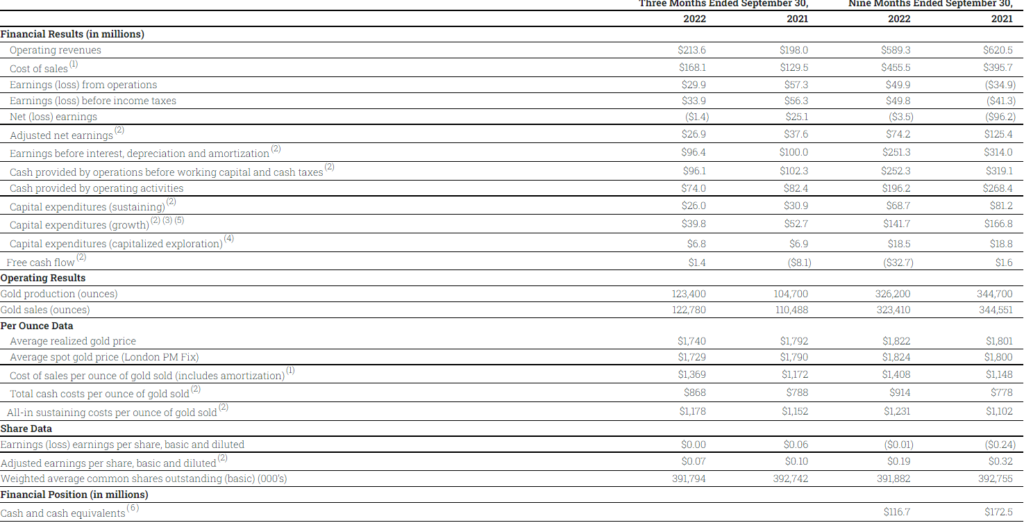
(1) Cost of sales includes mining and processing costs, royalties, and amortization expense. For the three and nine months ended September 30, 2022, cost of sales includes a $11.6 million and $33.9 million non-cash inventory net realizable value adjustment, respectively, at Mulatos District.
(2) Refer to the “Non-GAAP Measures and Additional GAAP Measures” disclosure at the end of this press release and associated MD&A for a description and calculation of these measures.
(3) Includes growth capital from operating sites.
(4) Includes capitalized exploration at Island Gold, Young-Davidson and Mulatos District.
(5) Includes capital advances of nil for the three and nine months ended September 30, 2022 ($1.3 million and $21.5 million for the three and nine months ended September 30, 2021).
(6) Comparative cash and cash equivalents balance as at December 31, 2021
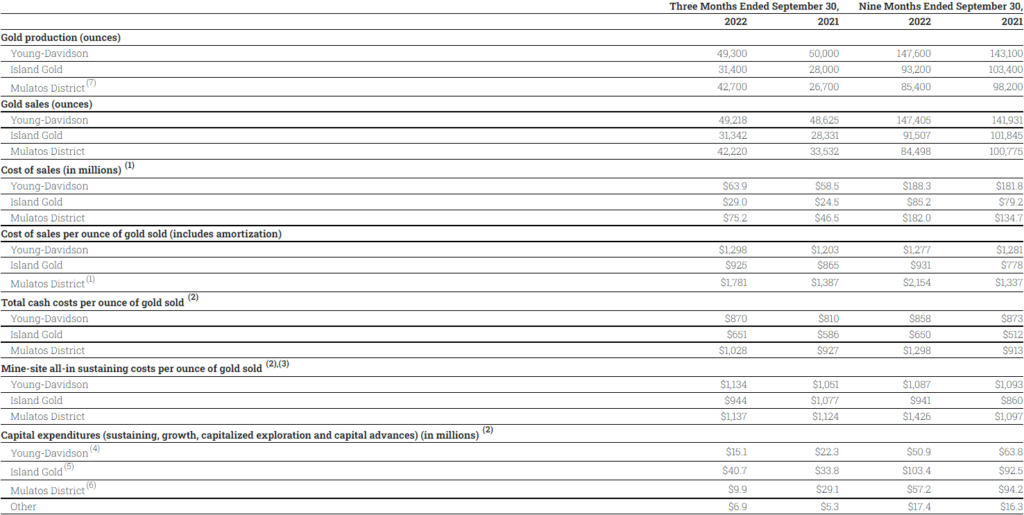
(1) Cost of sales includes mining and processing costs, royalties, and amortization. For the three and nine months ended September 30, 2022, cost of sales includes $11.6 million and $33.9 million non-cash inventory net realizable value adjustment, respectively, at Mulatos District.
(2) Refer to the “Non-GAAP Measures and Additional GAAP Measures” disclosure at the end of this press release and associated MD&A for a description and calculation of these measures.
(3) For the purposes of calculating mine-site all-in sustaining costs, the Company does not include an allocation of corporate and administrative and share based compensation expenses.
(4) Includes capitalized exploration at Young-Davidson of $1.2 million and $3.5 million for the three and nine months ended September 30, 2022 ($1.3 million and $3.8 million for the three and nine months ended September 30, 2021).
(5) Includes capitalized exploration at Island Gold of $4.7 million and $13.9 million for the three and nine months ended September 30, 2022 ($5.2 million and $13.6 million for the three and nine months ended September 30, 2021).
(6) Includes capitalized exploration at Mulatos District of $0.9 million and $1.1 million for the three and nine months ended September 30, 2022 ($0.4 and $1.4 million for the three and nine months ended September 30, 2021).
(7) The Mulatos district includes both the Mulatos pit, as well as La Yaqui Grande.
Environment, Social and Governance Summary Performance
Health and Safety
- Total recordable injury frequency rate1,2 (“TRIFR”) of 2.08, a 39% increase from the second quarter of 2022
- Lost time injury frequency rate1 (“LTIFR”) of zero
- Year-to-date TRIFR of 1.74 and LTIFR of 0.06, a decline of 15% and 71%, respectively from 2021
During the third quarter of 2022, the TRIFR increased with 25 recordable injuries, seven more than the prior quarter. Zero lost time injuries were recorded in the quarter. On a year-to-date basis, the Company has significantly improved its TRIFR and LTIFR compared to 2021.
Alamos strives to maintain a safe, healthy working environment for all, with a strong safety culture where everyone is continually reminded of the importance of keeping themselves and their colleagues healthy and injury-free. The Company’s overarching commitment is to have all employees and contractors return Home Safe Every Day.
Environment
- Zero significant environmental incidents in the third quarter of 2022 and year-to-date
- Information sessions held on the Company’s cyanide management practices with the communities of Yécora, El Trigo and Matarachi in Mexico, within the framework of the International Cyanide Management Code
- Island Gold received additional construction permits for the shaft site haul road and site powerline
- Continued to advance federal and provincial permitting of the Lynn Lake project
- Completed the transition from propane to compressed natural gas at Young-Davidson, which will reduce greenhouse gas emissions at the site by an estimated 15% for mine underground heating
One reportable spill occurred during the third quarter at Island Gold when 200 litres of thickener slurry leaked due to a pinhole in a pipeline. The spill was identified and all material collected and moved back into the containment area. The area was cleaned and remediated with no anticipated long-term effects. The Company is committed to preserving the long-term health and viability of the natural environment that surround its operations and projects. This includes investing in new initiatives to reduce our environmental footprint with the goal of minimizing the environmental impacts of our activities and offsetting any impacts that cannot be fully mitigated or rehabilitated.
Community
Ongoing donations and medical support being provided to local communities, including:
- Donation of an ambulance to the Sahuaripa municipality,
- Establishment of an online high school for Matarachi residents through an agreement with Tec de Monterrey,
- Commissioning of two freshwater pumping stations in Matarachi
- New scholarship committees established in Matarachi, Sahuaripa and Yécora as part of the Company’s continued support for local students
Alamos believes that excellence in sustainability provides a net benefit to all stakeholders. The Company continues to engage with local communities to understand local challenges and priorities. Ongoing investments in local infrastructure, health care, education, cultural and community programs have continued through the COVID-19 pandemic, with appropriate health and safety protocols.
Governance and Disclosure
- Published Alamos’ 2021 ESG Report and 2021 ESG Summary Tables, outlining the Company’s progress on its ESG performance across its operations, projects and offices
- Recipient of the Ethics and Values Award by the National Confederation of Industrial Chambers (CONCAMIN) for the third consecutive year at Mulatos
Alamos maintains the highest standards of corporate governance to ensure that corporate decision-making reflects its values, including the Company’s commitment to sustainable development. During the quarter, the Company continued to advance its implementation of the Responsible Gold Mining Principles, developed by the World Gold Council as a framework that sets clear expectations as to what constitutes responsible gold mining.
(1) Frequency rate is calculated as incidents per 200,000 hours worked.
(2) The classification of medical treatment injuries was updated retroactive to 1 January 2020 to align with OSHA standards, resulting in changes to previously reported recordable injury rates.
Outlook and Strategy

(1) Refer to the “Non-GAAP Measures and Additional GAAP” disclosure at the end of this press release and associated MD&A for a description of these measures.
(2) Includes growth capital and capitalized exploration at the Company’s development projects.
(3) For the purposes of calculating mine-site all-in sustaining costs at individual mine sites, the Company does not include an allocation of corporate and administrative and share based compensation expenses to the mine sites.
(4) Cost of sales includes mining and processing costs, royalties, and amortization expense, and is calculated based on the mid-point of total cash cost guidance.
The Company’s objective is to operate a sustainable business model that can support growing returns to all stakeholders over the long-term through growing production, expanding margins, and increasing profitability. This includes a balanced approach to capital allocation focused on generating strong ongoing free cash flow while re-investing in high-return internal growth opportunities and supporting higher returns to shareholders.
The Company delivered on two key long-term objectives this year which have solidified its strong outlook. This included achieving initial low-cost production at La Yaqui Grande and announcing the Phase 3+ Expansion of Island Gold, which will create a larger, more profitable and valuable operation.
La Yaqui Grande performed well during its first full quarter of operation, driving a 19% increase in consolidated production from the second quarter, at significantly lower costs compared to the first half of the year. The Company expects this strong performance to continue in the fourth quarter with consolidated production increasing to between 125,000 and 135,000 ounces, driven by further low-cost production growth at La Yaqui Grande. Despite industry-wide inflationary pressures, total cash costs are expected to decrease in the fourth quarter to the lowest level of the year with the ramp up of low-cost production at La Yaqui Grande, higher grades at Island Gold, and the weaker Canadian dollar.
With production through the first nine months of 326,200 ounces and higher production and lower costs expected in the fourth quarter, the Company is well positioned to achieve full year production and cost guidance.
Young-Davidson continues to perform well, generating $23.3 million of mine-site free cash flow in the quarter, bringing year-to-date mine-site free cash flow to $77.3 million. With production of 147,600 ounces through the first nine-months, Young-Davidson is on track to meet full year production and cost guidance, and is expected to generate $100 million of mine-site free cash flow for the second straight year.
Island Gold produced 93,200 ounces through the first nine months of the year, and with higher grades expected in the fourth quarter, the operation is well positioned to achieve full year production guidance. Construction activities on the Phase 3+ Expansion are ramping up with pre-sinking of the shaft having started in August. Capital spending rates are expected to continue to increase with the ramp up of activities on the Phase 3+ Expansion; however, full year spending is expected to be lower than guidance with capital deferred to subsequent years.
The Phase 3+ Expansion of Island Gold will result in a step change in production, with mining rates increasing to 2,400 tpd from the current rate of 1,200 tpd. This is expected to more than double gold production to average 287,000 ounces per year at industry low mine-site all-in sustaining costs of $576 per ounce starting in 2026 upon completion of the shaft. Given strong ongoing cash flow from operations, the majority of the Phase 3+ Expansion capital over the life of the project is expected to be self-funded by Island Gold.
Combined production from the Mulatos District totaled 85,400 ounces through the first nine-months of 2022. This included 42,700 ounces in the third quarter, at significantly lower costs than the first half of the year driven by the ramp up of low cost production from La Yaqui Grande. Total production from the Mulatos District is expected to increase further in the fourth quarter at lower costs, and is on track to meet full year production and cost guidance.
At Lynn Lake, the Company continues to focus on environmental work in support of permitting, detailed engineering and other site access upgrades. Spending in 2022 has been focused on both development and exploration activities, with $17 million spent through the first nine-months of the year. The approval of the Environmental Impact Statement (“EIS”) for the project is expected by the end of 2022 or early 2023, following which the Company expects to release an updated feasibility study.
The Company’s liquidity position remains strong, ending the quarter with $116.7 million of cash and cash equivalents, $15.3 million in equity securities, and no debt. Additionally, the Company has a $500 million undrawn credit facility, providing total liquidity of $616.7 million.
As part of the Company’s balanced approach to growth and capital allocation, the current focus of growth capital is the Phase 3+ Expansion at Island Gold. With no significant capital expected to be spent on developing Lynn Lake until the Phase 3+ Expansion is well underway, the Company remains well positioned to fund this growth internally while generating strong free cash flow over the next several years. The Company expects significant free cash flow growth starting in 2025 as production rates ramp up at Island Gold.
Third Quarter 2022 results
Young-Davidson Financial and Operational Review
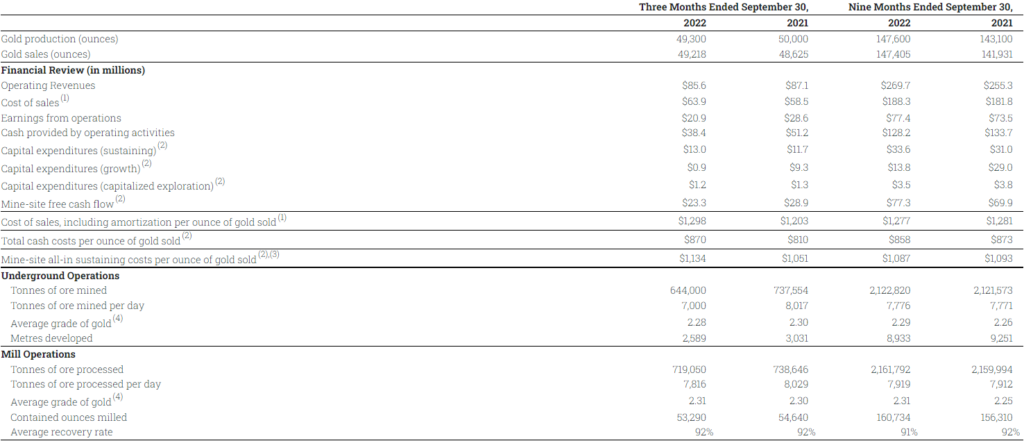
(1) Cost of sales includes mining and processing costs, royalties and amortization.
(2) Refer to the “Non-GAAP Measures and Additional GAAP Measures” disclosure at the end of this press release and associated MD&A for a description and calculation of these measures.
(3) For the purposes of calculating mine-site all-in sustaining costs, the Company does not include an allocation of corporate and administrative and share based compensation expenses.
(4) Grams per tonne of gold (“g/t Au”).
Young-Davidson produced 49,300 ounces of gold in the third quarter of 2022, consistent with the prior year period reflecting similar tonnes and grades processed. With production of 147,600 ounces for the first nine-months of 2022, the operation is on track to meet full year production guidance.
Underground mining rates were lower than the prior year period, averaging 7,000 tpd in the third quarter. Mining rates were impacted by downtime to replace the head ropes within the Northgate Shaft, a scheduled replacement of an underground conveyor belt, and an increased frequency of energy reductions during periods of peak provincial electricity demand in the summer months. Underground mining rates are expected to increase in the fourth quarter and average 8,000 tpd. Grades mined averaged 2.28 g/t Au, within the annual guidance of between 2.15 and 2.35 g/t Au.
Mill throughput averaged 7,816 tpd in the third quarter at an average grade of 2.31 g/t Au. Milling rates were consistent with the first half of 2022, though slightly lower than the prior year period and guidance, reflecting the above noted energy reduction program. Milling rates exceeded mining rates during the quarter with underground ore mined and stockpiled in previous quarters supplementing mill feed. Mill recoveries averaged 92% in the quarter, in line with guidance and the prior year period.
Financial Review
Third quarter revenues of $85.6 million were 2% lower than the prior year period reflecting a lower realized gold price. Year-to date revenues of $269.7 million were 6% higher than the prior year period, primarily driven by more ounces sold.
Cost of sales (which includes mining and processing costs, royalties, and amortization expense) of $63.9 million in the third quarter were higher than the prior year period, due to higher unit mining costs, partially offset by the weaker Canadian dollar. Underground unit mining costs were CAD $50 per tonne in the quarter, higher than the prior year and previous quarters, primarily due to the lower mining rates, as well as inflationary cost pressures. Cost of sales of $188.3 million in the first nine months of 2022 were higher than the comparable period given higher input costs and more ounces sold.
Total cash costs of $870 per ounce in the third quarter were 7% higher than the prior year period driven by the higher unit mining costs in the quarter, partially offset by the weaker Canadian dollar. Mine-site AISC of $1,134 per ounce in the third quarter were 8% higher than the prior year period, consistent with the increase in total cash costs. Total cash costs and mine-site AISC for the first nine months were both lower than the comparable period as a result of higher production. Given the strong operational performance to-date, Young-Davidson remains well positioned to meet full year total cash cost and mine-site AISC guidance.
Capital expenditures in the quarter included $13.0 million of sustaining capital and $0.9 million of growth capital. In addition, $1.2 million was invested in capitalized exploration in the quarter. Capital expenditures totaled $50.9 million in the first nine-months of 2022, a 20% decrease from the prior year and in line with annual guidance.
Young-Davidson has consistently generated strong free cash flow since transitioning to the lower mine infrastructure in mid-2020, which has driven production higher and unit mining costs lower. This included mine-site free cash flow of $23.3 million in the third quarter of 2022 and $77.3 million for the first nine months of 2022, putting the operation on track to generate $100 million of mine-site free cash flow for the second consecutive year.
Island Gold Financial and Operational Review
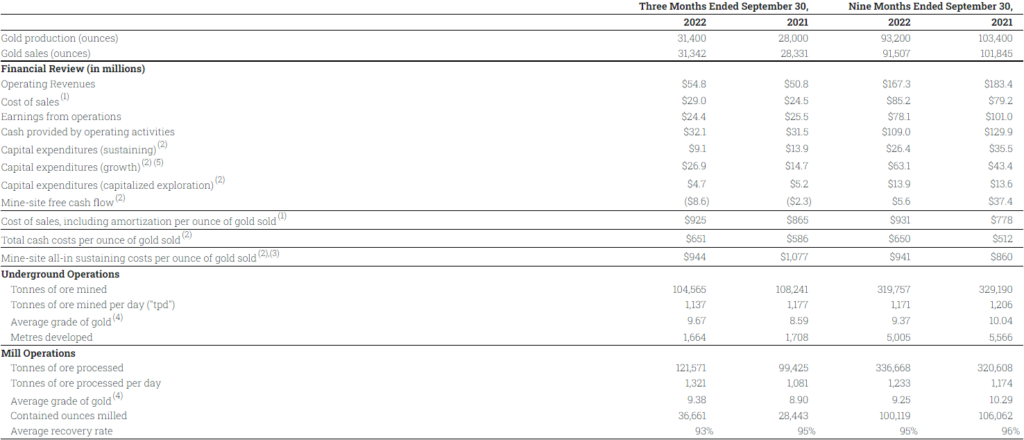
(1) Cost of sales includes mining and processing costs, royalties, and amortization.
(2) Refer to the “Non-GAAP Measures and Additional GAAP Measures” disclosure at the end of this press release and associated MD&A for a description and calculation of these measures.
(3) For the purposes of calculating mine-site all-in sustaining costs, the Company does not include an allocation of corporate and administrative and share based compensation expenses.
(4) Grams per tonne of gold (“g/t Au”).
(5) Includes capital advances of nil and $1.4 million for the three and nine months ended September 30, 2022 ($0.6 million and $3.4 million for the three and nine months ended September 30, 2021).
Island Gold produced 31,400 ounces in the third quarter of 2022, a 12% improvement from the prior year period reflecting higher grades mined and higher tonnes processed. Through the first nine months of 2022, Island Gold produced 93,200 ounces and remains on track to meet full year production guidance.
Underground mining rates averaged 1,137 tpd in the third quarter, with grades averaging 9.67 g/t Au. Mining rates were slightly below guidance as a result of production drilling availability, but have improved in the fourth quarter. Mining rates and grades mined through the first nine-months of the year were in line with guidance.
Mill throughput averaged 1,321 tpd, 10% above annual guidance of 1,200 tpd, reflecting the processing of approximately 10,000 tonnes of Island Gold stockpiled ore at the Young-Davidson mill. Given current permit limits at Island Gold, excess stockpiles were trucked to Young-Davidson during the second and third quarters and processed as capacity was available at the Young-Davidson mill, boosting production and cash flow.
Mill recoveries averaged 93% in the quarter, below annual guidance and the prior year period due to calibration issues with a newly installed automated lime application system. This issue was identified and rectified with recoveries returning to budgeted levels before the end of the quarter and into October. The new system is performing well with recoveries expected to be at budgeted levels in the fourth quarter.
Financial Review
Island Gold generated revenues of $54.8 million in the third quarter, an 8% increase compared to the prior year period, driven by 11% more ounces sold, partially offset by a lower realized gold price. For the first nine months of the year, revenues were $167.3 million, lower than the prior year period as a result of less ounces sold, partially offset by a higher realized gold price.
Cost of sales (includes mining and processing costs, royalties and amortization expense) of $29.0 million in the third quarter were 18% higher than the prior year period, reflecting both higher tonnes processed and unit mining costs, partially offset by a weaker Canadian dollar. Cost of sales of $85.2 million in the first nine-months of 2022 were higher than the comparable period given similar reasons.
Total cash costs of $651 per ounce in the third quarter were higher than the prior year period, due to higher mining and processing costs, partially offset by higher grades processed. Mine-site AISC of $944 per ounce in the third quarter were lower than the prior year period due to the timing of sustaining capital expenditures. Total cash costs and mine-site AISC for the first nine months were both higher than the comparable period as a result of lower grades processed and higher mining and processing costs.
Total capital expenditures were $40.7 million in the third quarter, including $4.7 million of capitalized exploration. Spending ramped up significantly on the Phase 3+ Expansion during the third quarter, including shaft site preparation and clearing, and the start of pre-sinking of the shaft. In addition, capital spending was focused on lateral development and other surface infrastructure. For the first nine-months of 2022, capital spending was $103.4 million, inclusive of capitalized exploration of $13.9 million, higher than the prior year period given the ramp up of construction activities on the Phase 3+ Expansion.
Island Gold generated negative mine-site free cash flow of $8.6 million in the third quarter given higher capital commitments related to the Phase 3+ Expansion, but had positive mine-site free cash flow of $5.6 million for the first nine-months of 2022. At current gold prices, Island Gold is expected to largely self-finance the Phase 3+ Expansion capital spending in 2022 and beyond.
Mulatos Financial and Operational Review
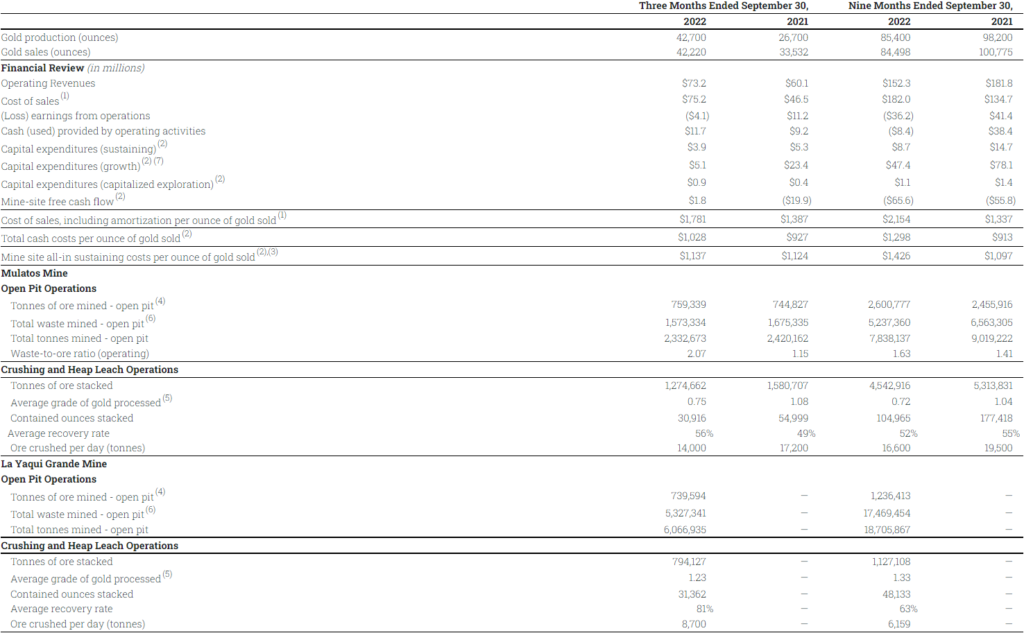
(1) Cost of sales includes mining and processing costs, royalties, and amortization. Cost of sales per ounce for the three and nine months ended September 30, 2022 includes the inventory net realizable value adjustment of $11.6 million and $33.9 million.
(2) Refer to the “Non-GAAP Measures and Additional GAAP Measures” disclosure at the end of this press release and associated MD&A for a description and calculation of these measures.
(3) For the purposes of calculating mine-site all-in sustaining costs, the Company does not include an allocation of corporate and administrative and share based compensation expenses.
(4) Includes ore stockpiled during the quarter.
(5) Grams per tonne of gold (“g/t Au”).
(6) Total waste mined includes operating waste and capitalized stripping.
(7) Includes a drawdown of capital advances of $1.4 million for the nine months ended September 30, 2022 ($0.7 million and $18.1 million of advances for the three and nine months ended September 30, 2021).
The Mulatos District produced 42,700 ounces in the third quarter from the Mulatos and La Yaqui Grande operations, representing a significant increase from the prior year period given the start of production at La Yaqui Grande in June 2022. The Mulatos District remains on track to achieve full year guidance with the ongoing ramp up in mining and stacking rates at La Yaqui Grande expected to drive a further increase in production in the fourth quarter at lower costs.
Mulatos Operational Review
Mulatos produced 17,400 ounces in the third quarter, representing a 14% increase from the second quarter. Approximately 60% of the ore stacked in the third quarter was from the El Salto portion of the pit, with the remainder from surface stockpiles. In the fourth quarter, El Salto ore is expected to comprise the majority of tonnes stacked on the Mulatos leach pad.
Total crusher throughput in the third quarter averaged 14,000 tpd, for a total of 1,274,662 tonnes stacked at a grade of 0.75 g/t Au, including surface stockpiles. Mining rates and tonnes stacked in the quarter were impacted by heavy rains, which limited the supply of consumables to site, including lime and diesel. With the rainy season concluded, the regular transport and supply of consumables to site has resumed and Mulatos expects to ramp up stacking rates to guided levels in the fourth quarter.
Recovery rates remained consistent with previous quarters at 56%, and continue to be impacted by the longer leach cycles associated with stacking of stockpiled ore.
La Yaqui Grande Operational Review
La Yaqui Grande is an open pit mine with an independent leach pad located approximately seven kilometres from the existing Mulatos operation. Construction was completed ahead of schedule in the second quarter with the operation achieving initial production in June 2022. La Yaqui Grande performed well in its first full quarter of operation, producing 25,300 ounces of gold.
During the third quarter, 739,594 tonnes of ore were mined. Mining and stacking rates continued to ramp up through the third quarter with the latter increasing to average 8,700 tpd, slightly below the design level of 10,000 tpd. As with Mulatos, mining and stacking rates in the quarter were impacted by heavy rains which temporarily limited the transport of consumables to site. Grades stacked on the leach pad in the quarter averaged 1.23 g/t Au, in line with the Mineral Reserve grade.
Financial Review (Mulatos District)
Revenues of $73.2 million in the third quarter were higher than the prior year period due to the start of production at La Yaqui Grande in June, 2022, which contributed 24,600 ounces sold in the quarter, offset by a lower realized gold price. For the first nine months of 2022, revenues of $152.3 million were lower than the prior year period driven by fewer ounces sold, partially offset by a higher realized gold price.
Cost of sales (includes mining and processing costs, royalties and amortization expense) of $75.2 million in the third quarter were higher than in the comparative period, driven by higher processing costs and a net realizable value adjustment to the Mulatos leach pad inventory balance. During the third quarter, the Company reviewed the carrying value of the Mulatos leach pad inventory to assess its recoverability. Given a decline in the gold price at period end and higher future processing costs, the Company recorded an adjustment to reduce the carrying value of Mulatos leach pad inventory, resulting in a non-cash net realizable value adjustment of $11.6 million ($7.7 million after tax). For the first nine months of 2022, cost of sales of $182.0 million were higher than the prior year period, primarily due to Mulatos leach pad inventory adjustments of $33.9 million ($22.4 million after tax).
Total cash costs for the Mulatos District of $1,028 per ounce were higher than the prior year period as a result of lower tonnes and grades stacked and higher processing costs, partially offset by low-cost production growth from La Yaqui Grande. The higher processing costs include inflationary pressures on key inputs, such as cyanide, as well as increased reagent consumption to process the surface stockpiles. Total cash costs for the Mulatos District includes production from La Yaqui Grande, which had significantly lower total cash costs in the period of $561 per ounce. Mine-site AISC for the Mulatos District of $1,137 per ounce (including $699 per ounce at La Yaqui Grande) in the quarter were consistent with the prior year period. For the first nine months, total cash costs and mine-site AISC were higher than the prior year, given heavier reliance on higher cost surface stockpiles in the first half of the year. With production increasing at La Yaqui Grande, both total cash costs and mine-site AISC are expected to decrease moving forward.
Capital spending totaled $9.9 million in the third quarter, down significantly from the first half of the year reflecting completion of construction of La Yaqui Grande in June. This included sustaining capital expenditures of $3.9 million, primarily relating to stripping costs at La Yaqui Grande, and capitalized exploration of $0.9 million. During the first nine-months of 2022, capital spending totaled $57.2 million.
The Mulatos District generated mine-site free cash flow of $1.8 million in the quarter driven by improving operating margins. Mine site free cash flow was impacted by working capital changes in the quarter, including an increase in VAT receivables and inventory.
Third Quarter 2022 Development Activities
Island Gold (Ontario, Canada)
Phase 3+ Expansion Study
On June 28, 2022, the Company reported results of the Phase 3+ Expansion Study (“P3+ Expansion Study”) conducted on its Island Gold mine, located in Ontario, Canada. The P3+ Expansion Study was an update to the Phase 3 Study (“P3 2000 Study”) released on July 14, 2020.
The P3+ Expansion Study was updated to reflect the current costing environment, as well as incorporate the significant growth in high-grade Mineral Reserves and Resources into an optimized mine plan. The P3+ Expansion Study outlines a larger, more profitable, and valuable operation than what was included in the P3 2000 Study released in 2020.
The Phase 3+ Expansion to 2,400 tpd from the current rate of 1,200 tpd will involve various infrastructure investments. These include the installation of a shaft, paste plant, and an expansion of the mill. This infrastructure was all incorporated into the P3 2000 Study with several scope changes to accommodate the 20% increase in production rates to 2,400 tpd including a larger mill expansion and paste plant, as well as accelerated development to support the higher mining rates. The Phase 3+ Expansion also includes 30% more development over the mine life to accommodate the 43% larger mineable resource.
Following the completion of the expansion in 2026, the operation will transition from trucking ore and waste up the ramp to skipping ore and waste to surface through the new shaft infrastructure, driving production higher and costs significantly lower.
Phase 3+ Expansion Study Highlights
- Higher production: average annual gold production of 287,000 ounces starting in 2026 upon completion of the shaft
- This represents a 22% increase from the P3 2000 Study and a 121% increase from the mid-point of 2022 production guidance of 130,000 ounces
- Industry low costs: consistent cost structure with the P3 2000 Study, with productivity gains and economies of scale offsetting inflation
- Average total cash costs of $432 per ounce (average $425 per ounce from 2026), consistent with the P3 2000 Study and 25% lower than the mid-point of 2022 guidance of $575 per ounce
- Average mine-site all-in sustaining costs of $610 per ounce (average $576 per ounce from 2026), a 30% decrease from the mid-point of 2022 guidance of $875 per ounce
- Larger, longer-life operation supported by significantly increased Mineral Reserve and Resources
- 43% increase in mineable resource to 4.6 million ounces of gold grading 10.59 g/t Au
- 18 year mine life to 2039, a four year increase from the P3 2000 Study, while operating at 20% higher production rates of 2,400 tpd
- Lower capital intensity: lower total capital per ounce over the life of mine
- Growth capital of $756 million and sustaining capital of $777 million, both up from the P3 2000 Study reflecting the expansion, a larger mineable resource, and industry-wide inflation
- Total capital intensity decreased 4% to $344 per ounce reflecting the larger mineable resource with increased ounces per vertical metre driving the lower capital intensity and contributing to the stronger economics
- $100 million of the increase in growth capital compared to the P3 2000 Study reflects sustaining capital that has been brought forward to the expansion period for accelerated underground development and infrastructure to support the higher mining rate
- Expansion significantly de-risked given increased detailed engineering, capital committed, and projects completed to date, including the majority of earthworks
- Stronger economics with expansion and larger mineable resource more than offsetting inflation to create a more valuable operation
- After-tax net present value (“NPV”) (5%) of $1.6 billion, a 25% increase from the P3 2000 Study (base case gold price assumption of $1,650 per ounce and USD/CAD foreign exchange rate of $0.78:1)
- After-tax internal rate of return (“IRR”) of 23%, up from 20% in P3 2000 Study
- After-tax NPV (5%) of $2.0 billion, a 31% increase from the P3 2000 Study, and an after-tax IRR of 25%, at gold prices of $1,850 per ounce
- Industry low Greenhouse Gas (“GHG”) emission intensity
- 35% reduction in life of mine GHG emissions relative to the current operation, supporting the company-wide target of a 30% reduction in GHG emissions by 2030
- 31% additional reduction in emissions per ounce of gold produced from already industry low levels
- Fully funded, balanced approach to growth: growing free cash flow expected starting in the second half of 2022
- With no significant capital expected to be spent on Lynn Lake until the P3+ Expansion is well underway; the Company is well positioned to fund the expansion internally while generating strong free cash flow over the next several years
- The Company expects significant free cash flow growth in 2025 and beyond as production rates ramp up at Island Gold
Construction activities continued to ramp up during the third quarter, with major activities including site clearing and preparation of the shaft area, pre-sinking of the shaft, and pouring the concrete foundation for shaft surface infrastructure. Further details on progress made as of the end of the quarter are noted below:
- Shaft site earthworks, access road to the shaft area and buried services excavation were more than 80% complete
- Shaft pre-sink commenced in August and is approximately 90% complete to date. The pre-sink is expected to be completed down to a 42 metre depth in November
- Commenced concrete foundation work on shaft surface infrastructure, including the hoist and hoist house
- Paste plant detailed engineering commenced in September
- Lateral development to support higher mining rates with the Phase 3+ Expansion remains ongoing
During the third quarter of 2022, the Company spent $26.9 million, exclusive of accounts payable and accruals, on growth capital related to the Phase 3+ expansion and capital development to support the expansion. Spending is expected to increase in the fourth quarter and into 2023 as construction activities ramp up.
Shaft site area – October 2022
A photo accompanying this announcement is available at https://www.globenewswire.com/NewsRoom/AttachmentNg/8183fed6-f04b-4aad-9b94-4d206e170b36
Lynn Lake (Manitoba, Canada)
The Company released a positive Feasibility Study on the Lynn Lake project in December 2017 outlining average annual production of 143,000 ounces over a 10 year mine life at average mine-site AISC of $745 per ounce.
The project economics based on the 2017 Feasibility Study at a $1,500 per ounce gold price include an after-tax internal rate of return (“IRR”) of 21.5% and an after-tax NPV of $290 million (12.5% IRR at a $1,250 per ounce gold price). The Company filed the Environmental Impact Statement (“EIS”) with the federal government in 2020. Approval of the EIS is expected towards the end of 2022 or early 2023, following which the Company expects to release an updated feasibility study on the project.
As part of the Company’s balanced approach to growth and capital allocation, no significant capital is expected to be spent on the development of Lynn Lake until the Phase 3+ Expansion at Island Gold is well underway.
Development spending (excluding exploration) was $2.0 million in the third quarter of 2022 and $8.0 million in the first nine months to support the ongoing permitting process and engineering.
Kirazlı (Çanakkale, Türkiye)
On October 14, 2019, the Company suspended all construction activities on its Kirazlı project following the Turkish government’s failure to grant a routine renewal of the Company’s mining licenses, despite the Company having met all legal and regulatory requirements for their renewal. In October 2020, the Turkish government refused the renewal of the Company’s Forestry Permit. The Company had been granted approval of all permits required to construct Kirazlı including the Environmental Impact Assessment approval, Forestry Permit, and GSM (Business Opening and Operation) permit, and certain key permits for the nearby Ağı Dağı and Çamyurt Gold Mines. These permits were granted by the Turkish government after the project earned the support of the local communities and passed an extensive multi-year environmental review and community consultation process.
On April 20, 2021, the Company announced that its Netherlands wholly-owned subsidiaries Alamos Gold Holdings Coöperatief U.A, and Alamos Gold Holdings B.V. (the “Subsidiaries”) would be filing an investment treaty claim against the Republic of Türkiye for expropriation and unfair and inequitable treatment, among other things, with respect to the Kirazlı, Ağı Dağı and Çamyurt gold development projects in Türkiye. The claim was filed under the Netherlands-Türkiye Bilateral Investment Treaty (the “Treaty”). Alamos Gold Holdings Coöperatief U.A. and Alamos Gold Holdings B.V. had its claim against the Republic of Türkiye registered on June 7, 2021 with the International Centre for Settlement of Investment Disputes (World Bank Group).
Bilateral investment treaties are agreements between countries to assist with the protection of investments. The Treaty establishes legal protections for investment between Türkiye and the Netherlands. The Subsidiaries directly own and control the Company’s Turkish assets. The Subsidiaries invoking their rights pursuant to the Treaty does not mean that they relinquish their rights to the Turkish project, or otherwise cease the Turkish operations. The Company will continue to work towards a constructive resolution with the Republic of Türkiye.
The Company incurred $2.2 million in the third quarter related to ongoing holding costs and legal costs to progress the Treaty claim, which was expensed.
Third Quarter 2022 Exploration Activities
Island Gold (Ontario, Canada)
Total exploration spending through the first nine months was $17.9 million, in line with the annual budgeted amount of $22 million for surface and underground exploration at Island Gold in 2022. Exploration remains focused on defining additional near mine Mineral Resources across the Island Gold Main Zone (Island Main, West, and East), as well as advancing and evaluating several regional targets.
A regional exploration program is also included in 2022 spending, with the focus on evaluating and advancing exploration targets outside the Island Gold Deposit on the 15,524-hectare Island Gold property.
During the third quarter, six diamond drill rigs were focused on the surface directional exploration program, as well as one drill rig focused on underground exploration drilling.
Surface exploration drilling
A total of 8,116 m of surface directional drilling was completed in 13 holes during the third quarter. Surface directional drilling targeted areas peripheral to Inferred Mineral Resource blocks in the Island West, Main, and East areas between 1,400 m and 1,800 m below surface with drill hole spacing ranging from 75 m to 200 m. In addition, a total of 4,077 m of surface regional diamond drilling was completed in eight holes during the third quarter in four target areas.
Underground exploration drilling
During the third quarter of 2022, a total of 5,817 m of standard underground exploration drilling was completed in 36 holes. The objective of the underground drilling is to identify new Mineral Resources close to existing Mineral Resource or Reserve blocks. A total of 80 m of underground exploration drift development was also completed during the third quarter.
Total exploration expenditures during the third quarter were $6.1 million, of which $4.7 million was capitalized. In the first nine months of 2022, the Company incurred exploration expenditures of $17.9 million, of which $13.9 million was capitalized.
Young-Davidson (Ontario, Canada)
The focus for the 2022 drill program is following up on the success in the 2020 and 2021 programs which extended gold mineralization below existing Mineral Reserves and Resources and intersected higher grades in the hanging wall and footwall of the deposit.
The 2022 program includes 21,600 m of underground exploration drilling, and 500 m of underground exploration drift development to extend drill platforms on the 9220, 9095, and 9025-levels. The focus of the underground exploration drilling program is to expand Mineral Resources in six target areas that have been identified within proximity to existing underground infrastructure. In addition, 10,000 m of surface drilling is planned to test near-surface targets across the 5,720 hectare Young-Davidson Property.
During the third quarter, underground exploration drilling was focused on two targets with 2,682 m completed in four holes. The first target included one hole drilled from the 8960-level exploration drill bay established in the lower mine infrastructure tested to the west and down-plunge of existing Mineral Reserves and Resources. Drilling is targeting syenite-hosted mineralization as well as continuing to test mineralization in the footwall sediments and in the hanging wall mafic-ultramafic stratigraphy. A second underground drill completed three holes from the 9220 West exploration drift testing down-plunge of the existing Mineral Reserves and Resources.
A total of 876 m of surface exploration drilling was completed in one hole during the quarter, continuing to test several targets as part of the 2022 regional exploration program.
Exploration spending totaled $2.0 million of which $1.2 million was capitalized in the third quarter 2022. For the first nine months of 2022, exploration spending totaled $7.5 million of which $3.5 million was capitalized.
Mulatos District (Sonora, Mexico)
The Company has a large exploration package covering 28,972 hectares with the majority of past exploration efforts focused around the Mulatos mine. Exploration continues to follow up on near-mine sulphide opportunities at Puerto del Aire, as well as several earlier stage prospects throughout the wider district.
During the third quarter of 2022, exploration activities continued at Puerto del Aire and the near-mine areas with 7,060 m of drilling completed in 25 holes. Drilling at Puerto del Aire in 2021 was successful in establishing a new underground Mineral Reserve at Mulatos, consisting of 0.4 million ounces of gold (2.8 mt grading 4.67 g/t Au) as at December 31, 2021. The focus in 2022 is on evaluating sulphide opportunities to expand this Mineral Reserve. The higher-grade ore from Puerto del Aire is expected to be processed through the existing mill at Mulatos. Ongoing exploration results will be incorporated into an updated development plan which is expected to be finalized in 2023.
Regional drilling was also completed at the Bajios and Halcon West targets. This included three drill holes totaling 730 m at Bajios and seven drill holes totaling 2,222 m at Halcon West.
During the third quarter, the Company incurred $3.0 million of exploration spending of which $0.9 million was capitalized. For the first nine months of 2022, the Company incurred $7.6 million of exploration spending of which $1.1 million was capitalized.
Lynn Lake (Manitoba, Canada)
During the third quarter of 2022, fifteen holes were drilled at the Tulune target, and two holes were completed at another regional target, totaling 5,818 m of drilling in the period. The 2022 drilling program was completed at the end of August, with a total of 57 holes, or 18,235 m completed in the year.
A summer field program progressed through the third quarter, consisting of geological mapping, prospecting and soil sampling that was designed to help advance a pipeline of prospective regional exploration targets to drill-ready stage. Interpretation of 2022 drilling and field program results and development of a 2023 program are currently in progress.
Exploration spending totaled $4.4 million in the third quarter and $8.9 million year-to-date, all of which was capitalized.
Review of Third Quarter Financial Results
During the third quarter of 2022, the Company sold 122,780 ounces of gold for revenues of $213.6 million, an 8% increase from the prior year period driven by more ounces sold, partially offset by a lower realized gold price.
The average realized gold price in the third quarter was $1,740 per ounce, a 3% decrease compared to $1,792 per ounce in the prior year period. The average realized gold price in the quarter was $11 per ounce above the London PM Fix price due to gains realized on settlement of gold collar contracts.
Cost of sales (which includes mining and processing costs, inventory net realizable value adjustment, royalties, and amortization expense) were $168.1 million in the third quarter, 30% higher than the prior year period.
Mining and processing costs were $104.2 million, 23% higher than the prior year period. The increase primarily reflects higher processing costs at Mulatos related to stockpiled ore, as well as higher mining and processing costs at both Young-Davidson and Island Gold, partially offset by a weaker Canadian dollar. These factors contributed to higher consolidated total cash costs in the quarter compared to the prior year period.
The Company assesses the net realizable value of inventory at each reporting period. Given the decrease in the gold price at the end of the third quarter, and higher processing costs at Mulatos, the Company recorded an $11.6 million ($7.7 million after tax) reduction in the net realizable value of the heap leach inventory. This included $9.6 million related to mining and processing costs and $2.0 million related to amortization.
Royalty expense was $2.4 million in the quarter, consistent with the prior year period of $2.6 million.
Amortization of $49.9 million in the quarter was higher than the prior year period due to the start of production at La Yaqui Grande, which commenced in June 2022. Amortization of $406 per ounce was lower than guidance, but 6% higher than the prior year period.
The Company recognized earnings from operations of $29.9 million in the quarter, lower than the prior year period as a result of lower realized gold prices, higher operating costs, and the net realizable value adjustment recorded in 2022.
The Company reported a net loss of $1.4 million in the quarter, compared to net earnings of $25.1 million in the prior year period. On an adjusted basis, earnings in the third quarter of 2022 were $26.9 million, or $0.07 per share, reflecting adjustments for the inventory net realizable value charge, as well as significant unrealized foreign exchange losses recorded within deferred taxes given the impact of the weakening Canadian dollar on Canadian dollar denominated tax pools.
Associated Documents
This press release should be read in conjunction with the Company’s interim consolidated financial statements for the three-month period ended September 30, 2022 and associated Management’s Discussion and Analysis (“MD&A”), which are available from the Company’s website, www.alamosgold.com, in the “Investors” section under “Reports and Financials”, and on SEDAR (www.sedar.com) and EDGAR (www.sec.gov).
Reminder of Third Quarter 2022 Results Conference Call
The Company’s senior management will host a conference call on Thursday, October 27, 2022 at 10:00 am ET to discuss the results. Participants may join the conference call via webcast or through the following dial-in numbers:
| Toronto and International: | (416) 340-2217 | ||||
| Toll free (Canada and the United States): | (800) 806-5484 | ||||
| Participant passcode: | 2437684# | ||||
| Webcast: | www.alamosgold.com |
A playback will be available until November 27, 2022 by dialling (905) 694-9451 or (800) 408-3053 within Canada and the United States. The pass code is 4259298#. The webcast will be archived at www.alamosgold.com.
Qualified Persons
Chris Bostwick, FAusIMM, Alamos’ Senior Vice President, Technical Services, who is a qualified person within the meaning of National Instrument 43-101 (“Qualified Person”), has reviewed and approved the scientific and technical information contained in this press release.
About Alamos
Alamos is a Canadian-based intermediate gold producer with diversified production from three operating mines in North America and a strong portfolio of growth projects. This includes the Young-Davidson and Island Gold mines in northern Ontario, Canada and the Mulatos mine in Sonora State, Mexico. Alamos employs more than 1,900 people and is committed to the highest standards of sustainable development. The Company’s shares are traded on the TSX and NYSE under the symbol “AGI”.
FOR FURTHER INFORMATION, PLEASE CONTACT:
Scott K. Parsons
Vice-President, Investor Relations
(416) 368-9932 x 5439
The TSX and NYSE have not reviewed and do not accept responsibility for the adequacy or accuracy of this release.
Cautionary Note Regarding Forward-Looking Statements
This press release contains or incorporates by reference “forward-looking statements” and “forward-looking information” as defined under applicable Canadian and U.S. securities legislation. All statements, other than statements of historical fact, which address events, results, outcomes or developments that the Company expects to occur are, or may be deemed, to be, forward-looking statements. Forward-looking statements are generally, but not always, identified by the use of forward-looking terminology such as “expect”, “assume”, “schedule”, “believe”, “anticipate”, “intend”, “objective”, “estimate”, “potential”, “forecast”, “budget”, “target”, “on track”, “outlook”, “continue”, “plan” or variations of such words and phrases and similar expressions or statements that certain actions, events or results “may”, “could”, “would”, “might” or “will” be taken, occur or be achieved or the negative connotation of such terms.
Such statements include, but may not be limited to, expectations pertaining to: remaining on track to achieve full year production and cost guidance; returns to shareholders; ramp up of mining and stacking rates at La Yaqui Grande and corresponding increases to production and decreases to costs; reductions in GHG emissions; increases to production and decreases to costs, including mine-site all-in sustaining costs, resulting from intended completion of the Phase 3+ expansion at Island Gold; intended infrastructure investments in, method of funding for, and timing of the completion of, the Phase 3+ expansion; approval of the Environmental Impact Study for the Lynn Lake Gold Project and the intended release of an updated feasibility study and timing related thereto; as well as other general information as to strategy, plans or future financial or operating performance, such as the Company’s expansion plans, project timelines, production plans and expected sustainable productivity increases, expected increases in mining activities and corresponding cost efficiencies, expected drilling targets and future exploration, expected sustaining costs, expected improvements in cash flows and margins, expectations of changes in capital expenditures, forecasted cash shortfalls and the Company’s ability to fund them, cost estimates, projected exploration results, reserve and resource estimates, expected mine life, expected production rates and use of the stockpile inventory, expected recoveries, sufficiency of working capital for future commitments and other statements that express management’s expectations or estimates of future plans and performance.
Alamos cautions that forward-looking statements are necessarily based upon a number of factors and assumptions that, while considered reasonable by the Company at the time of making such statements, are inherently subject to significant business, economic, technical, legal, political and competitive uncertainties and contingencies. Known and unknown factors could cause actual results to differ materially from those projected in the forward-looking statements and undue reliance should not be placed on such statements and information.
Such factors and assumptions underlying the forward-looking statements in this document include, but are not limited to: changes to current estimates of mineral reserves and resources; changes to production estimates (which assume accuracy of projected ore grade, mining rates, recovery timing and recovery rate estimates which may be impacted by unscheduled maintenance, weather issues, labour and contractor availability and other operating or technical difficulties); operations may be exposed to new diseases, epidemics and pandemics, including the continued and potential future effects of COVID-19; the impact of COVID-19 on the broader market and the trading price of the Company’s shares; provincial and federal orders or mandates (including with respect to mining operations generally or auxiliary businesses or services required for the Company’s operations) in Canada, Mexico, the United States and Türkiye; the duration of regulatory responses to the COVID-19 pandemic; government and the Company’s attempts to reduce the spread of COVID-19 which may affect many aspects of the Company’s operations including the ability to transport personnel to and from site, contractor and supply availability and the ability to sell or deliver gold doré bars; fluctuations in the price of gold or certain other commodities such as, diesel fuel, natural gas, and electricity; changes in foreign exchange rates (particularly the Canadian Dollar, Mexican Peso, U.S. Dollar and Turkish Lira); the impact of inflation; changes in the Company’s credit rating; any decision to declare a quarterly dividend; employee and community relations; litigation and administrative proceedings (including but not limited to the investment treaty claim announced on April 20, 2021 against the Republic of Türkiye by the Company’s wholly-owned Netherlands subsidiaries, Alamos Gold Holdings Coöperatief U.A, and Alamos Gold Holdings B.V.); disruptions affecting operations; availability of and increased costs associated with mining inputs and labour; delays with the Phase 3+ expansion project at the Island Gold mine; delays in permitting, construction decisions and any development of the Lynn Lake project; the risk that the Company’s mines may not perform as planned; uncertainty with the Company’s ability to secure additional capital to execute its business plans; the speculative nature of mineral exploration and development, including the risks of obtaining and maintaining necessary licenses and permits, including the necessary licenses, permits, authorizations and/or approvals from the appropriate regulatory authorities for the Company’s development stage and operating assets; labour and contractor availability (and being able to secure the same on favourable terms); contests over title to properties; expropriation or nationalization of property; inherent risks and hazards associated with mining and mineral processing including environmental hazards, industrial hazards, industrial accidents, unusual or unexpected formations, pressures and cave-ins; changes in national and local government legislation (including tax and employment legislation), controls or regulations in Canada, Mexico, Türkiye, the United States and other jurisdictions in which the Company does or may carry on business in the future; increased costs and risks related to the potential impact of climate change; failure to comply with environmental and health and safety laws and regulations; disruptions in the maintenance or provision of required infrastructure and information technology systems; risk of loss due to sabotage, protests and other civil disturbances; the impact of global liquidity and credit availability and the values of assets and liabilities based on projected future cash flows; risks arising from holding derivative instruments; and business opportunities that may be pursued by the Company. The litigation against the Republic of Türkiye, described above, results from the actions of the Turkish government in respect of the Company’s projects in the Republic of Türkiye. Such litigation is a mitigation effort and may not be effective or successful. If unsuccessful, the Company’s projects in Türkiye may be subject to resource nationalism and further expropriation; the Company may lose any remaining value of its assets and gold mining projects in Türkiye and its ability to operate in Türkiye. Even if successful, there is no certainty as to the quantum of any damages award or recovery of all, or any, legal costs. Any resumption of activities in Türkiye, or even retaining control of its assets and gold mining projects in Türkiye can only result from agreement with the Turkish government. The investment treaty claim described in this press release may have an impact on foreign direct investment in the Republic of Türkiye which may result in changes to the Turkish economy, including but not limited to high rates of inflation and fluctuation of the Turkish Lira which may also affect the Company’s relationship with the Turkish government, the Company’s ability to effectively operate in Türkiye, and which may have a negative effect on overall anticipated project values.
Additional risk factors and details with respect to risk factors affecting that may affect the Company’s ability to achieve the expectations set forth in the forward-looking statements contained in this press release are set out in the Company’s latest 40-F/Annual Information Form under the heading “Risk Factors”, which is available on the SEDAR website at www.sedar.com or on EDGAR at www.sec.gov. The foregoing should be reviewed in conjunction with the information, risk factors and assumptions found in this press release.
The Company disclaims any intention or obligation to update or revise any forward-looking statements whether as a result of new information, future events or otherwise, except as required by applicable law.
Original Article: https://www.alamosgold.com/news-and-events/news/news-details/2022/Alamos-Gold-Reports-Third-Quarter-2022-Results/default.aspx





















